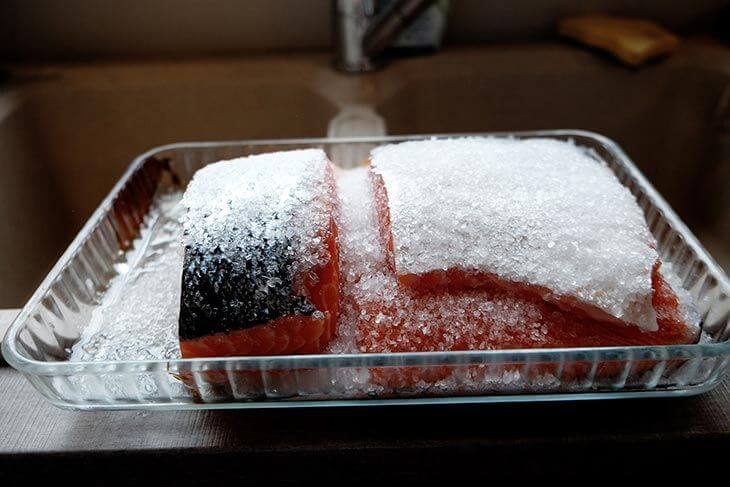Have you ever wanted to cook salmon for dinner only to realize that you haven’t defrosted your fish yet? I have, so I know it’s not always easy to wait for it to completely thaw out.
Cooking frozen salmon may ruin its flavor and texture, so you should avoid doing this as much as possible. Instead, you should allocate enough time to defrost your fish properly so that you get to keep its nutrients and flavor intact.
If you want to know how to defrost salmon, then here are three easy ways you can choose from. Your choice will depend on how much time you have before you need to cook your dish and how concerned you are about safely defrosting it.
Option 1: Defrosting in the Refrigerator
The safest way to defrost salmon is to let it naturally thaw out in the refrigerator for at least 12 hours. To do this, you need to plan your meal ahead of time so you’d know when to take out your fish from the freezer and transfer it to the refrigerator.
For this method, you will need the following:
- Plastic wrap
- Large bowl
- Refrigerator
Procedure:
Take out the salmon from the freezer at least 12 hours before you cook your dish. If your salmon is more than 1 pound, you may need to take it out of the freezer at least 24 hours before cooking time.
Remove the salmon from its packaging and wrap it in plastic wrap. Place the wrapped salmon in a bowl big enough to hold the entire fish.
Place the bowl in the refrigerator. Try to look for a corner that is far away from sweet food or any other dish that may absorb the fishy smell of the salmon. You can also cover the bowl with plastic wrap to prevent the smell of the fish from leaking out.
Check your salmon after 12 hours. Once it has sufficiently thawed out, remove it from the refrigerator and cook it immediately.
Option 2: Defrosting with Cold Water

If you’re in a hurry, you can also defrost your salmon by using cold tap water. Leslie Stephens of Food 52 gives detailed instructions on how to do this in her article “How to Defrost Your Fish Faster (and Things to Do While You Wait.)”
For this method, you will need the following:
- Zip-lock bag
- Large bowl
- Cold water
Procedure:
Remove the salmon from its packaging and transfer it to a zip-lock bag. Squeeze out the excess air in the bag and then seal it close.
Place the sealed salmon in a bowl large enough to hold the entire fish. This is important because you need to submerge the whole fish under water so that it will defrost evenly.
Move the bowl to your sink and fill it will cold tap water from the faucet. While using hot water may seem like a good idea because it will thaw out your fish faster, you should avoid doing this because you may risk bacteria growth.
Make sure the whole fish is submerged in the water. You can use a jar or another bowl to weigh down the bag if it floats to the top of the bowl.
Check the salmon every ten minutes and replace the water in the bowl until the fish completely thaws out. Make sure you cook the salmon immediately because fish tends to go bad quickly if left uncooked for long periods of time.
Option 3: Defrosting in the Microwave

I personally don’t recommend defrosting salmon in the microwave because I don’t like the extra radiation it will absorb. Microwave heating may also cause the salmon’s meat to dry up in some places, resulting in an unevenly defrosted fish.
However, if you need to defrost your fish at the quickest possible way, then you may do this as a last resort. For this method, you will need the following:
- Microwave-proof bowl or plate
- Paper towels
- Microwave
Procedure:
Place a paper towel in a microwave-proof bowl or plate. The bowl or plate should be big enough to hold the salmon.
Remove the salmon from its wrapper and transfer it to the bowl or plate. Try to position the salmon so that the thinnest sections are placed in the middle of the container. Cover your fish with another paper towel.
Set the microwave to Defrost and adjust the timer to 5 minutes for every 1 pound of salmon. Let the microwave run for 2 ½ minutes and then stop it so you can flip the salmon to the other side. Continue thawing for about 1 minute.
Remove the salmon from the microwave when only a few ice crystals remain in the fish. Don’t over-thaw the fish in the microwave because this will make it soggy in some places and dry in other parts. Instead, let it continue defrosting in room temperature for another 5 minutes.
Cook the fish the immediately.
Conclusion
I prefer to defrost my salmon overnight in the refrigerator because I think it’s the best way to keep my fish safe from bacteria growth. However, thawing the fish with cold tap water is a good alternative if you don’t want to wait 12 hours to cook your dish.
Did this article make you crave for salmon? Which method is your favorite? Let me know in the comments’ section below. And don’t forget to share this article with your salmon-loving friends. Happy eating!




























Thanks for the handy tips!